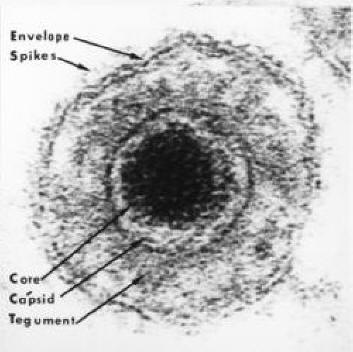Like all herpesviruses, the Epstein-Barr virus is relatively large and complex. The virus's structure consists of an envelope, spikes, a core, a capsid and a tegument. All these structures aid in making the virus successful in the infection process and as a means of avoiding detection from our body's immune system.
Spikes:
The "spikes" that
are visible in the picture below are the many
 glycoproteins that coat
the outside surface of the virus envelope. These proteins are
a means of attachment for the virus when it encounters potential
host cells. With these proteins, the virus can latch on to the
host cell surface and begin the replication cycle. These
proteins are also a means of finding host cells, as their proteins
will bind only with those specialized receptor cells on the host.
glycoproteins that coat
the outside surface of the virus envelope. These proteins are
a means of attachment for the virus when it encounters potential
host cells. With these proteins, the virus can latch on to the
host cell surface and begin the replication cycle. These
proteins are also a means of finding host cells, as their proteins
will bind only with those specialized receptor cells on the host.
Envelope:
The envelope is a protective outer membrane that surrounds the virus. This is the membrane covered in the glycoproteins mentioned above. The virus acquires these proteins and envelope when it leaves a host cell. The virus buds out of the host cell and takes the membrane along with its receptor proteins. The viral envelope is not very sturdy and can be easily damaged. A damaged envelope means that the virus is not able to infect host cells and therefore is not able to cause pathology in people. While the envelope does protect the virus and hold it together structurally, it does have its downsides. The membrane is very sensitive to drying out, acids, detergents, and many other organic solvents. This occurs because of the membrane being made of lipids.
Core:
The core holds the double-stranded DNA and is enclosed inside all of the other structures. The core has a toroidal shape, which means that it resembles a donut. The DNA is wound around special proteins in the middle of the core. The core measures about 75 nanometeres in diameter.
Capsid:
The capsid surrounds the core and protects the genetic information (double-stranded DNA). The capsid itself has a nucleocapsid with a icosahedral shape, which means it has twenty sides. The capsid measures about 95-105 nanometers in diameter.
Tegument:
The tegument is the space between the capsid and envelope. This space is filled with proteins, and handles proteins and enzymes needed for replication and prepares them to do so.
To learn more about the disease these structures help cause, click here!
